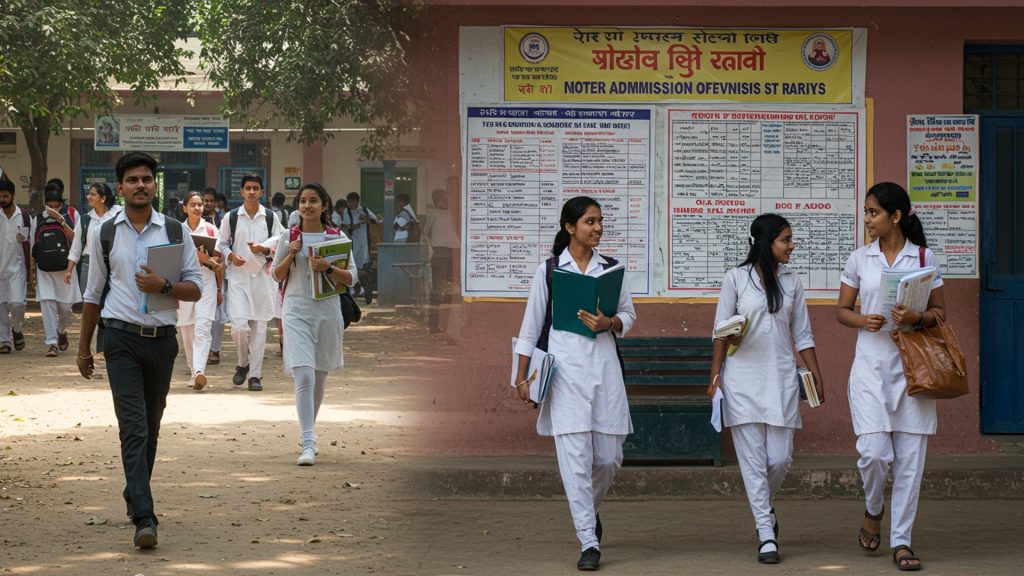Madhya Pradesh sees a record surge in students joining undergraduate courses this year, reaching an all-time high across colleges and universities. This strong interest in basic degrees stands in sharp contrast to a worrying drop in students signing up for postgraduate studies. While thousands eagerly fill seats for initial college education, the numbers for advanced degrees remain surprisingly low. This trend highlights a growing gap in student choices and raises questions about the future of higher education in the state right now.
Current Enrollment Trends in Madhya Pradesh
New data from Madhya Pradesh shows a clear trend in college admissions. A large number of students are seeking to enroll in undergraduate courses, reaching a peak in recent application cycles. At the same time, the number of students applying for postgraduate programs is lower, showing a lag compared to the strong interest in first-degree courses. This situation highlights a notable difference in how students are choosing their path in higher education across the state. Latest figures from the Department of Higher Education show that out of approximately 10. 17 lakh total seats available in government and private colleges for both undergraduate and postgraduate courses, around 3. 25 lakh students have registered. Specifically, for undergraduate courses, where there are about 8 lakh seats, 2. 35 lakh students have applied. For postgraduate courses, with 2. 17 lakh seats, only 1. 10 lakh applications have been received. These numbers, as part of the ongoing online counseling process, indicate a much higher fill rate for undergraduate programs in the initial phase of admissions.
Growth in Undergraduate Student Numbers
The significant interest in undergraduate education in Madhya Pradesh is a continuing trend. Many students view a bachelor’s degree as a necessary step for their future. The state has more than 1,300 colleges and universities, serving a large student population of around 1. 6 million, which makes up about 10 percent of India’s total higher education enrollment. This wide network of institutions offers many options for students wishing to pursue a basic degree. The rise in undergraduate admissions can be linked to a growing awareness among families about the importance of a college degree. Government efforts to expand access to education also play a part. Many students are eager to get a first degree to improve their chances of finding a job. The variety of courses, including arts, commerce. science, allows a broad range of students to find programs that fit their interests.
“The National Education Policy (NEP) 2020 has brought in many new ideas in the state. Universities have been asked to make higher education better. We are always working to improve the quality of education,” stated Chief Minister Dr. Mohan Yadav. He also noted that 1. 29 lakh students in Madhya Pradesh are now taking courses that mix different subjects, showing a move towards wider learning options.
Challenges for Postgraduate Admissions
In contrast to the high demand for undergraduate studies, postgraduate enrollments are facing challenges. Data shows that fewer students are opting for master’s or doctoral degrees. This trend is not just seen in Madhya Pradesh but is part of a wider picture. For example, interest from Indian students in postgraduate programs in the United States saw a significant drop of 36. 8 percent in early 2025. Globally, while master’s enrollment has seen overall growth, there has been a slight decrease after a peak. fewer admitted students are actually enrolling in master’s programs. Several factors may be contributing to this situation in Madhya Pradesh:
- Many graduates might prefer to enter the job market right after their first degree, especially if they find suitable employment.
- The added cost and time commitment of a postgraduate degree might be seen as a barrier if the immediate job market benefit is not clear.
- There might be a need for more specialized or industry-linked postgraduate programs that directly meet current job demands.
- Some students might also be looking at options outside the state or country for advanced studies, affecting local enrollment numbers.
What Education Experts Observe
Experts in education are observing these trends closely. They point out that while a strong base of undergraduate students is good for overall education access, a lower number of postgraduate students could affect the state’s capacity for advanced research and specialized skills. A balanced approach is essential for a complete higher education system. Some experts suggest that the current job market might be influencing student choices. If entry-level jobs are widely available for bachelor’s degree holders, some students might not see the immediate need for further studies. This can lead to a gap in highly specialized skills needed for certain industries or research fields.
“The main reason behind this is negligence of administration and corruption at grass root levels,” stated one source regarding reasons for lower international standing of India’s Higher Education system and overall quality concerns. But, it is also noted that the overall outlook for graduate education remains positive with increasing applications for admission to U. S. graduate schools, although enrollment growth trends are slowing.
The National Education Policy 2020 aims to make education more relevant to the needs of the workforce. This includes focusing on skill development. The state government has set up 47 incubation centers to help with new ideas and business creation. These centers are in government universities, private universities. government autonomous colleges. Such steps can help make postgraduate studies more appealing by linking them to real-world job opportunities and innovation.
Future Steps in Higher Education
To encourage more students to pursue postgraduate education, the state’s higher education department is focusing on several key areas. The goal is to make advanced degrees more attractive and relevant to the changing needs of industries. This includes improving the quality of courses and ensuring they lead to better job opportunities. Efforts are being made to develop programs that are more employment-oriented. Universities are being encouraged to offer courses that directly match the needs of the job market. This might include new specialized programs or collaborations with industries to ensure students gain skills that are in high demand. The government is also looking at how to provide better support for postgraduate students, which could include scholarships or research opportunities. The aim is to make higher education accessible and valuable for all students, whether they choose to pursue undergraduate or postgraduate studies. This balanced approach is considered essential for the overall development of Madhya Pradesh’s workforce and its contribution to specialized knowledge and innovation.

